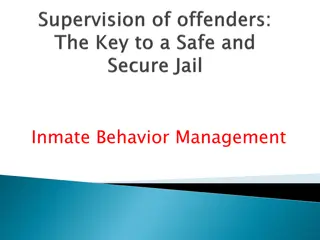Promoting Positive Behavior in School, Home, and Community
This presentation by Elena Garcia-Albea, Ph.D., BCBA-D, focuses on promoting positive behavior in school, home, and the community. It covers strategies like teaching and reinforcing replacement behaviors, preventing unwanted behaviors, and understanding the reasons behind behavior. The goal is to create a supportive environment for children and individuals to thrive.
Download Presentation

Please find below an Image/Link to download the presentation.
The content on the website is provided AS IS for your information and personal use only. It may not be sold, licensed, or shared on other websites without obtaining consent from the author.If you encounter any issues during the download, it is possible that the publisher has removed the file from their server.
You are allowed to download the files provided on this website for personal or commercial use, subject to the condition that they are used lawfully. All files are the property of their respective owners.
The content on the website is provided AS IS for your information and personal use only. It may not be sold, licensed, or shared on other websites without obtaining consent from the author.
E N D
Presentation Transcript
PROMOTING POSITIVE BEHAVIOR AT SCHOOL, HOME, AND IN THE COMMUNITY Bedminster Township School School-Family Partnership Series Elena Garcia-Albea, Ph.D., BCBA-D
WHAT CAN WE DO? Why is he / she doing that? 1 Teach and reinforce (positive) replacement behaviors 2 Identify ways to PREVENT behavior from occurring 3 Change the consequence after the problem behavior (reduce behavior) 4
1. WHY IS HE/SHE DOING THAT? When/Where is the behavior happening? Time of day With a specific person During certain tasks What is happening after the behavior occurs? All behavior happens for a reason .. Attention Escape/avoidance Restricted access (Tangible) Automatic Reinforcement (Sensory)
Behavioral Function I don t want to do this! (Escape) Difficult tasks Prolonged Work Social Demands I don t want to be in this place I don t want to be with this person! I want attention! I Wantthis! I like doing this! (Attention) From parents From teachers From peers From siblings From anyone (Tangible) A toy An object A food or treat An activity A privilege (Sensory) It feels good It looks good It sounds good It tastes good It s a habit The Function of Wanting Power/Control Generally not supported in the research literature. What may seem like power and control may be attempts to access peer attention/access adult attention/escape a task
Behavior Change Helping a child change their behavior is best done by the adults around the child changing what THEY are doing. Set the environment up for success! Blaming the child by labeling them stubborn or defiant not useful or accurate Unclear expectations Inconsistent expectations Teacher/parent has lack of resources Areas for skill building
2. TEACH AND REINFORCE REPLACEMENT BEHAVIORS WHAT DOES THIS MEAN? Alternative behaviors Incompatible behaviors WHAT DOES THIS LOOK LIKE? What do you want your child to do instead??? Teach that response
3. IDENTIFY WAYS TO PREVENT BEHAVIOR FROM OCCURRING Strategies that focus on structuring and modifying the environment and conditions that occur BEFORE an unwanted behavior so that the behavior is LESS likely to occur PROACTIVE APPROACH Examples: Room set up Reviewing rules Transition warnings Visual schedules Reducing demands (reasonably)
OTHER PROACTIVE STRATEGIES.. Break down complex tasks into smaller, individualized teaching units Incorporate preferred materials or interests into tasks Make it fun! Provide choice when presenting a demand Provide high levels of contingent praise/feedback
4. CHANGE THE CONSEQUENCE AFTER THE PROBLEM BEHAVIOR Strategies that focus on structuring and modifying the environment and conditions that occur AFTER behavior occurs Used to minimize reinforcement for problem behavior and increase reinforcement for desirable behavior. Everyday Examples: Praise Allowances Certificates Extra credit Reprimand Detention Speeding ticket
REINFORCE DESIRED BEHAVIORS Reinforcers are your behavior change tools. Identify and control them! Reinforcement: anything that increases a behavior Can be getting preferred things (e.g., toys, attention, food) Can be getting rid of bad things (e.g., demands, bedtime, shoes) Reprimands and negative attention can sometimes be reinforcers Reinforcement can increase desired and undesired behavior Negative behavior often gets reinforced more often than positive behavior. Different for each person and changes frequently What may reinforce my behavior will not reinforce your behavior! Set up lots of opportunities for good/correct behavior (Don t just wait for them)
THE POWER OF REINFORCEMENT Reinforcement is the foundation of any behavior change program Effectiveness relies heavily on the reinforcers you use Can be used to teach a wide array of different behaviors Teaches NEW behavior in a way that is positive and strengths-based Spend most of your time rewarding your child for what they are doing right, rather than correcting the things that go wrong Only give reinforcers when your child engages in the desired behavior Any behavior you want to see more of should be reinforced!
TAKE-AWAYS All behavior happens for a reason Anticipate your child s needs before his/her undesired behavior forces you to meet his needs Avoid situations that you think might make the child irritable (or have a plan ready) Staying out past their bedtime Shopping for a long time Reinforcement is the foundation of any effective behavior change program Catch your child being good !!! Teach others in the home what you have learned today (Consistency is crucial) Be a good role model Have lots of fun with your kids!
egarcia@bedminsterschool.org (908) 234-0768 x100























